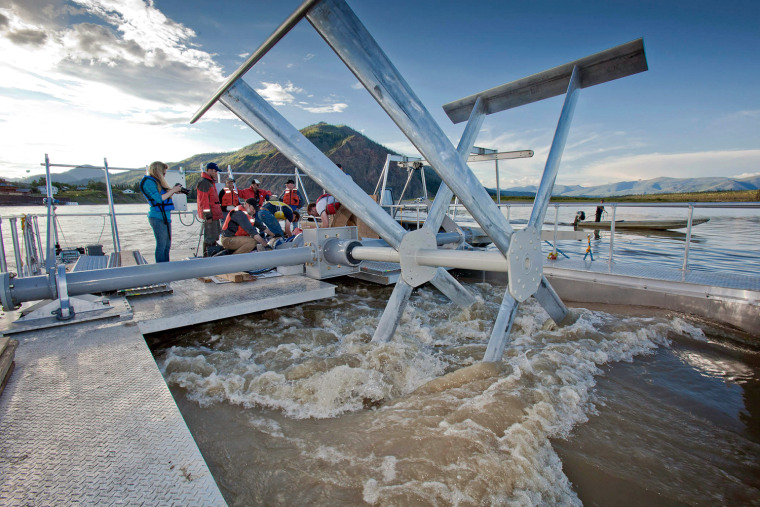The powerful flow of the Mississippi River, which brought destruction to scores living near its flooded banks this spring, is viewed by a new generation of energy entrepreneurs as a reliable alternative way of generating electricity.
These developers aren't planning giant concrete dam projects that brought electric lights to many Americans for the first time. Instead, their idea is to put turbines on the bottoms of rivers and mount them from barges to spin generators.
It's all part of the emerging technology of hydrokinetics — using flowing water to generate power without dams.
"If we're going to control the cost of converting to new forms of energy, hydro has to be part of that equation," said , project development director for Boston-based Free Flow Power, which wants to generate energy from the Mississippi River.
Hydrokinetic generation isn't a new idea — but only in recent years has technology made it feasible.
"Water speeds vary and, years ago, generators weren't built and developed for variable speed," said , chief executive of Olney, Texas-based . "In the last few years, they make very efficient generators that can operate in a wide range of speeds."
Still, developers are faced with many challenges, such as current low prices for electricity that have bedeviled other alternative energy forms and a technology that is still in its infancy. Widespread application is years away, and no one is yet willing to predict how much power could eventually be generated nationwide by hydrokinetics.
"I'd say hydrokinetic generators are at the stage where the wind generators were 15 years ago," said , research professor at the with the at Fairbanks.
FFP is focusing on obtaining federal permits for 25 hydrokinetic projects along the lower Mississippi River between Kentucky and Louisiana. Sites were chosen based on flow volume, flow velocity and the proximity to transmission facilities and potential customers. At each site, hundreds of turbines on pylons at the bottom of the river would spin like propellers and transmit energy to the riverbank.
Each turbine would produce about 40 kw of power, comparable to gasoline and diesel-powered home generators. By comparison, small wind turbines used to power homes and small businesses typically have capacities of 100 kilowatts or less.
Guidroz said FFP's long-term goal is to operate turbines for utilities and for chemical industries along the river. The company began testing one in June at a plant in Plaquemine, La. The company said that in addition to private funding, it received a $1.4 million grant from the .
The cost of a turbine, for now, is an FFP trade secret.
Ballard said turbines also could be strung below some existing dams to produce additional power.
"Your infrastructure is already there," he said. "It's not like a wind farm where you might to build 200 miles of infrastructure."
And flowing water can be had away from rivers. Gulfstream Technologies began a pilot hydrokinetic project in December 2009 at a power plant on a lake in Texas. The turbine uses the flow of water that comes from the plant following cooling cycles.
Guidroz said he wasn't deterred about the flood of 2011, saying that underwater turbines could easily be designed to handle the raging river.
"If anything, it proves the awesome power of the river and the potential for hydrokinetics," he said.
Some hydrokinetic testing is also taking place in Alaska, where powering isolated villages is a challenge.
Alaska Power & Telephone Co., which provides electricity to 33 communities with populations of 60 to 3,000, hopes the technology can reduce the use of room-sized diesel generators that still account for 30 percent of the power it provides.
Using a $1.8 million federal grant, the company built an aluminum barge mounted with a power turbine that dipped into the Yukon River. Last year, the generator provided part of the power for Eagle Village — population 50. The barge was later pulled back because of drifting wood, and the Institute of Northern Engineering is working on a device to divert debris, Johnson said. Another trial could take place next year.
AP&T believes the technology can be developed for widespread and bigger generation, said , the company's marketing director.
Developers are trying to deal with environmental concerns.
In a study that will be sent to the , FFP is assessing whether its turbines would affect shipping or fishing on the Mississippi. The commission will have to approve any large-scale uses of river turbines.
Both FFP and Gulfstream Technologies say their turbines are environmentally friendly. FFP's turbines use no chemical lubricants, Guidroz said. The company also put larger gaps between the turbine blades so large species can pass through safely, at the expense of some generating efficiency. Gulfstream Technologies has opted for a biodegradable lubricant, Ballard said.
But the cost has killed the plans of other developers.
Marine services company Inc. thought its proximity to the Ohio River was a natural reason to get into hydrokinetic generation. However, the South Point, Ohio-based company found small-scale generation wasn't economically feasible and a larger operation required development costs that were too high, said its legal counsel .
The company tried to get federal help, but was turned aside.
Douglas Meffert, executive director of 's RiverSphere, a planned hydrokinetic testing facility along the Mississippi River in New Orleans, said the technology will need federal support for commercial development.
"Every renewable energy source that has moved into commercial use, such as solar and wind, has always had to depend upon that initial subsidy," he said.
A small amount of federal money in tight budget times is now available, but that support depends upon matching funds from other sources, including private investors, Meffert said.
"This economy is slowing down the development of an industry that shows so much promise," he said.
